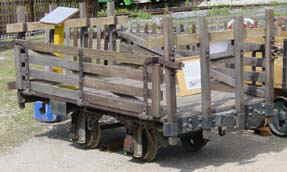 | ||
The Lincolnshire potato railways were a network of private, 1 ft 11 1⁄2 in (597 mm) narrow gauge farm railways which existed in the English county of Lincolnshire in the mid-20th century, for the purposes of transporting the annual potato crop between the fields and the nearest standard-gauge main line railhead.
Contents
Major systems
There were two major systems of potato railways: one located near the village of Nocton (the "Nocton Estate Light Railway" south of Lincoln), centred on Nocton and Dunston railway station; the other to the north of Holbeach in the south of the county, serving Fleet and Sutton Bridge stations. There were other, smaller systems elsewhere in Lincolnshire, for example at Deeping St Nicholas.
Closure
All of the potato railways were closed by 1969; their duties taken over by farm lorries. Some of the rolling stock and track from the Nocton system have been preserved at the Lincolnshire Coast Light Railway near Skegness.
History
The following text was posted anonymously and erroneously in the Cleethorpes Coast Light Railway article.
"My grandmother was a Dennis my grandmother’s father was WH Dennis a prominent farmer in Lincolnshire ……The Dennis family were probably the most successful potato farming family in Great Britain. W. Dennis and Sons as the firm was called, owned large estates at Nocton (8,000 acres), Deeping St Nicholas (2,000 acres) and Kirton (2,000 acres).
The Estate Manager for the Dennis family was none other than my Grandad, Major Leonard "Jock" Webber It was his job to look after the running of the farms all over Nocton area. Jock Webber was inspired by his father, Henry Webber, Head of the Burstow Hunt, Stock Broker and the oldest man to have died in WW 1 at 67, that he contacted the MOD and secured a deal to purchase the narrow gauge line from an Army Surplus Depot in Arras, France. The track had been used as a re-supply line during the First World War.
Initially just 4 miles of the one foot eleven and a half inch gauge was established at Nocton... on the heavy fenland east of Wasp's Nest. After 1926, the narrow gauge line was greatly extended in order that it could be connected to the railhead on the Lincoln to Sleaford mainline. The weight of the line at Nocton, because of the intensive use of locomotives, was 20lb per yard.
In the end, the route amounted to almost 23 miles of single track (on the Nocton Estate alone). Eventually they were to operate over 30 miles of line in total. Almost every field on the large estates was reached so that produce could be harvested straight onto trucks.
The railhead (located near the old Dunston/Nocton Station) consisted of Estate workshops, a mill, greenhouse and engine shed. There was a 'dock' for offloading the produce into lorries on the standard gauge railway wagons (located in a siding - a loop of the Lincoln/Sleaford main line).
The Layout of the Farms
At the mill was a large green baize covered board with an Estate field plan and the railway route marked on it. Each field was numbered and each wagon number was attached to a pin. Every wagon movement was noted by a traffic controller.
In 1927 the Bardney Beet Factory was built. Sugar beet from the Nocton Estate was transported to the factory by a mechanical grab running along a gantry over the River Witham, where it was picked up from a dump, from rail trucks dispersing their load.
The Estate's main customer however was Smith's Potato Crisps and it was this company that finally bought the land from W. Dennis & Sons in 1936. At its peak, Nocton estate was using 220 working horses, had 1,000 cattle, up to 3,000 pigs and 2,000 sheep Tractors were introduced in 1948 (24) and increased in number in 1951 (32). In 1955 the Estate was still producing some 17,000 tons annually - however since World War 2 and the growth of road transport, the rural roads had improved allowing articulated lorries to gain access to each farmstead. By 1960 almost all fields were accessible by road, this sounding the death knell for the light railway.
Engines and rolling stock from Nocton have survived and can be seen at the Lincolnshire Coast Light Railway near Skegness."
